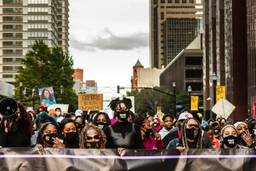On August 21, 1971, George Jackson was shot down during an attempted escape from San Quentin State Prison. Jackson, who had authored the highly-regarded prison memoir Soledad Brother the year before, co-founded the Black Guerilla Family and quickly emerged as one of the leading voices for black liberation in the early days of the black power movement. A mere two weeks later, on the opposite end of the country, Attica prison in New York became the site of the nation’s most deadly prison uprising. Forty-seven years since the climax of each, the dates were chosen as bookends to prisoner-led protests that swept the country in recent weeks. Out in front were organizations like Jailhouse Lawyers Speak (JLS), a human rights group made up of currently incarcerated individuals.
These protests, centered on 10 demands, are an echo of those earlier episodes when prisoners banded together so that they might inch their way towards something more closely resembling freedom. And perhaps no demand speaks more clearly to the spirit of that impulse than the second: “An immediate end to prison slavery” by ensuring that every incarcerated person is “paid the prevailing wage in their state or territory for their labor.” The shared experience of being forced to labor against one’s will brings other chilling similarities to light, like the fact that, disproportionately black and brown, today’s captive population looks an awful lot like earlier generations of forced labor. But there’s also something spectacular and awe-inspiring in the other direction: in past and present instances of slave labor, the victims have mounted an organized resistance to their plight.
While the comparison might sound extreme, it is the best way to illuminate the basic reality of forced labor behind bars. Jared Ware is a freelance journalist and outside spokesman for JLS. He tells In These Times that prisoners relate their condition to slavery on two grounds. The first is that the 13th Amendment never actually banned the practice, and in fact, explicitly permits its ongoing use for anyone convicted of a crime:
Neither slavery nor involuntary servitude, except as a punishment for crime whereof the party shall have been duly convicted, shall exist within the United States, or any place subject to their jurisdiction.
But the Constitution is a document drafted in a world nearly 250 years removed from our own, and in a radically different context. That’s why the second reason prisoners charge slavery is grounded in something more concrete: the experience of those who perform forced labor, as defined on their own terms.
“I can remember my great granddaddy and them, they were talking about it,” a representative of JLS told Ware, who’s interviewed JLS members periodically over the years. “They never really referred to it as prison or as jail, they referred to it as being forced back onto the plantations again. This is something we’ve always understood.”
Even this is an understatement. Prison labor is a billion-dollar industry. Incarcerated individuals do everything from sewing to extinguishing wildfires to literally picking cotton on still-operating Louisiana plantations. Those who labor behind bars are not only paid an absolute pittance (sometimes as little as pennies) if at all, but they labor under threat of violence. As Nathan Robinson of Current Affairs argues, slavery is the only way to describe an arrangement in which people are made to do things or be dragged away.
American Slave Rebellions — Past and Present
Once we accept that the term slavery is indeed the right one for what’s happening here, we can then draw out other similarities between the experiences — namely, the powerful role the victims themselves have played in resisting their captivity.
In A Nation Under Our Feet, historian Steven Hahn documents in rich detail the role that black Americans have played in not only shaping American political life, but in cultivating a sense of themselves as a people with shared political aspirations. One of the more fascinating stretches of the book comes with the discussion of enslaved life in the Confederate south. There’s an often-unspoken assumption that slaves had no real political lives to speak of — they just labored under the terror of the whip while waiting for history to take place, playing little-to-no role in shaping it. But Hahn’s work really should vanquish this myth. Throughout the course of the Civil War, especially towards the end as cracks in the plantation system began to surface, enslaved people would sometimes band together, refusing to work or carrying out other small acts of disruption in order to bargain for better working conditions.
In one example highlighted by Hahn, as Union forces moved south, slaves in one Louisiana parish seized on the “rearranged balances of power and negotiation” in the fall of 1862, telling their overseer:
…that they would not work anymore unless they got paid…shortly thereafter Woodland, together with a number of surrounding sugar estates, adopted a wage system. Only the large Magnolia Plantation seemed to hold the line by promising laborers engaged in a slowdown a “handsome present” when the crops were harvested…Within a month, the Magnolia slaves had demanded a month’s pay, and they commenced another slow down when the demand was rejected. Not long after, all the women went on strike and refuse to return to the fields despite the urgings of a federal army officer brought in to encourage cooperation; a week later they were joined by the men. By the end of October, the only worked that the hands had completed was a chilling site to the plantation managers: they had erected a gallows in the quarters, claiming to have been told that they “must drive [the managers] off the plantation[,] hang their master &c and that then they will be free. With this, Magnolia’s absentee owner apparently had enough. He promised compensation once the crop was gathered and sold, and the slaves went back to work.
Meanwhile, on a plantation near New Orleans:
Objecting to a newly hired overseer who “was in the habit of wielding the whip pretty freely and of using abusive language to the negro women,” a “delegation of field hands” approached the master one morning and “very respectfully stated their objections”. He would have none of it, told them he could hire whomever he pleased, and sent them off. They promptly “went to their cabins, packed up their bundles, and started on the road to Fort Jackson [where]… they knew they could get employment.” They had not gone far before the master reconsidered. “He called them back [and] told them they should have any overseer they wanted.”
Hahn’s great contribution here is twofold. First, he makes clear that any history of American labor that doesn’t include black people is a work of weaselly nonsense. Black Americans’ role in forging that history runs much deeper and begins much earlier than widely acknowledged. Second, he reveals how slaves and the newly freed saw themselves not just as victims of the cruelest fantasies white supremacy could imagine, but of a savage form of labor exploitation as well.
Today, captive people — who are forced to labor without fair pay, and face physical retaliation if they decide the arrangement is bullshit — are mounting a collective effort to disrupt a system of viciously racist economic exploitation. As the second of their chosen anniversaries lapsed this past Sunday, marking 47 years since Attica erupted with the demands of its captive population for basic dignity, protests in at least 20 facilities across the country were coming to a close.
“Hey, I’m for disruption!” the JLS representative exclaimed to Ware. “That’s what comrade George Jackson said, ‘I’m for disruption,’ as long as we’re disrupting the system and not destroying each other.” The disruptors, he added, should remember how easily the past can reach across the present. “The system evolved, it’s a little more sophisticated, and you know people tried to change the language and there was a disconnect,” he said, continuing: “But I think we do a grave injustice when we just ignore the fact that it’s still a continuation of slavery.”
The threads binding America’s presently chained labor force with its first are not only in the basic features of their experience, but in their will to resist, together. And as another JLS representative told Ware, that resistance is only a step toward a much deeper quest for genuine freedom where it’s been denied. It’s worth remembering that in 1863, satisfying that demand ultimately took something far more radical than many of its time thought possible: abolition.
ELI DAY was an investigative fellow with In These Times’ Leonard C. Goodman Institute for Investigative Reporting. He’s also a Detroiter, where he writes about politics, policy, racial and economic justice. His work has appeared in Vox, Current Affairs, Mother Jones, and the New Republic, among others.








